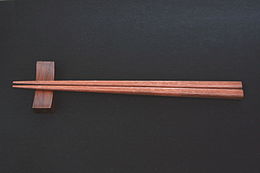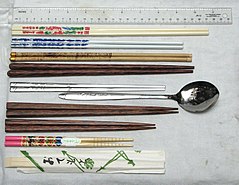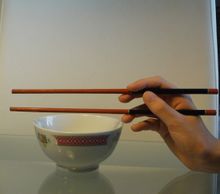|
Vikidia currently has 4,621 articles. Improve it! |
|
Join Vikidia: create your account now and improve it! |
Chopsticks

Chopsticks are sticks used in pairs as cutlery. Chopsticks are the traditional eating utensils of some countries including China, Japan, Korea, Taiwan, and Vietnam. They are usually made of wood bamboo, or plastic. Gold, silver or ivory chopsticks also exist but are rare or considered to be extravagant.
Today chopsticks are mainly used in China and neighboring countries. In other countries chopsticks are often used in restaurants of those countries' cuisines.
History[edit | edit source]
Chopsticks came from China as early as the Shang dynasty (1600–1100 Template:BC).[1] The creation of chopsticks might have been influenced by the teachings of Confucius.[2] They were widely used throughout East Asia. Tools like chopsticks were also found in the archaeological site Megiddo in Israel. This discovery may mean there was some form of trade between the Middle East and Asia in early antiquity. Alternatively, such tools may have developed independently in both the Middle East and Asia. Chopsticks were also common household items of civilized Uyghurs on the Mongolian steppes during the 6th–8th centuries.[3]
Where the word for Chopstick is from[edit | edit source]
The English word "chopstick" seems to come from Chinese Pidgin English, a pidgin where "chop chop" meant quickly.[4][5]
The Mandarin Chinese word for chopsticks is kuàizi (筷子). It is a word made of different parts; it has the phonetic part of "快", which means quick, and a semantic part, 竹, meaning bamboo. In Chinese, the old word for "chopsticks", and also in some varieties of modern Chinese such as Hokkien, was zhù (MC: Template:Unicode) (箸 Pinyin:zhù, Minnan: tī). However, zhù became a taboo on ships because it sounded the same as another word meaning "to stop" (住). Consequently, it was replaced by a word of opposite meaning, kuài (fast, quick). This gradually spread until it became the word for "chopsticks" in most varieties of modern Chinese. The character for this new meaning of "chopsticks" (筷) for kuài has the semantic element of bamboo added to the character meaning "fast" kuài (快).[6]
In Japanese, chopsticks are called hashi, written 箸. They are also known as otemoto (おてもと). This is what is usually printed on disposable chopsticks.
In Korean, 箸 (jeo) is used in the compound jeotgarak (젓가락) which is composed of jeo (chopsticks) and garak (stick). Jeo cannot be used alone.
In Vietnamese, chopsticks are called "đũa".
Eating with chopsticks[edit | edit source]
When people are eating with chopsticks they usually do not use a knife and fork. The sticks are held together in the same hand. Usually this is the right hand.[7] At some formal occasions it may be considered rude to use chopsticks with the left hand.[8]
- Put one chopstick between the palm and the base of the thumb, using the ring finger (the fourth finger from the thumb) to support the lower part of the stick. With the thumb, squeeze the stick down while the ring finger pushes it up. The stick should be stationary and very stable.
- Use the tips of the thumb, index and middle fingers to hold the other stick like an ink pen. Make sure the tips of the two sticks line up.
- Move the upper stick up and down towards the stationary lower stick.
- With enough practice, the two sticks function like a pair of pincers (a tool that can easily lift things).
If the tips do not line up, it will be difficult to hold things. Hold the chopsticks upright with one of the tips lightly touching the table, and gently push the chopsticks down or gently loosen your grip for a moment to let both tips become equal in length. You can also adjust your grip or holding position this way.
With practice, it is possible to perform step one and two right away, on picking up the chopsticks with one hand smoothly. Hold the chopstick at different angles if necessary in order to feel comfortable with two sticks between your fingers.
Table manners[edit | edit source]
Etiquette[edit | edit source]
Chopsticks are used in many countries; those eating with chopsticks generally observe the following rules:
- Chopsticks are not used to make noise, to draw attention, or to gesture. Playing with chopsticks is considered rude and vulgar (just as playing with cutlery in a Western environment would be).
- Chopsticks are not used to move bowls or plates.
- Chopsticks are not used to toy with food or with the dishes in common.
- Most often, chopsticks are not used to stab food. Exceptions include tearing larger items apart such as vegetables and kimchi. In informal use, small, difficult-to-pick-up items such as cherry tomatoes or fishballs may be stabbed, but this use is frowned upon by traditionalists.
- Chopsticks can be rested horizontally on one's plate or bowl to keep them off the table entirely. A chopstick rest can be used to keep the points off the table.
- Chopsticks should not be left standing vertically in a bowl of rice or other food. Any stick-like object pointed upward resembles the incense sticks that some people use as offerings to deceased family members; certain funerary rites designate offerings of food to the dead using standing chopsticks.
- Do not eat when the tips of a pair of chopsticks are not aligned properly. In Chinese, this is called "三长两短" (san1 chang2 liang2 duan3), which means death.[9]
Types of chopsticks[edit | edit source]

Chopsticks are used in many countries. Chopsticks are sometimes different in those countries.
- Chinese: longer sticks that are square at one end (where they are held) and round at the other (where they contact the food). They end with a blunt tip.
- Japanese: short to medium length sticks that have a pointed end. This development may have occurred because the Japanese diet consists of large amounts of whole fish. Japanese chopsticks are traditionally made of wood and are lacquered. Some chopstick sets include two lengths of chopsticks: shorter ones for women and longer ones for men. Child-sized chopsticks are widely sold.
- Korean: medium-length stainless-steel tapered rods, with a flat rectangular cross section. (Traditionally, they were made of brass or silver.) Many Korean metal chopsticks are decorated at the grip.
- Vietnamese: long sticks that end in blunt point; traditionally wooden, but now made of plastic as well. A đũa cả is a large pair of flat chopsticks that is used to serve rice from a pot.
Other uses for chopsticks[edit | edit source]
Chopsticks are used in cooking to stir materials in a pan, or to help move meals.
In Japan, people use a single-use chopstick called waribashi (split chopstick). Before using, people split it into two.[10] Japanese people also call their chopsticks hashi.
In Japan, people use chopsticks during the funeral ceremony of Buddhists. After burning the dead, family and friends use chopsticks to move the burned bones of the dead from the coffin to a pot.[11]
Chopsticks and the environment[edit | edit source]
Using a set of chopsticks only once, and then throwing them away causes problems for the environment.[12][13] There are some movements which aim at telling people to use a set of chopsticks more than once.[14] In China, about 45 billion pairs of disposable chopsticks are used per year. This is equal to 1.7 billion cubic metres of timber–about 25 million fully grown trees. China is the biggest producer of disposable chopsticks, about 60,000 people have a job making chopsticks. If production continues at the current level, China's forests will be gone in about a decade.[13]
For this reason, a tax has been introduced on chopsticks that are only used once. There are also moves to replace disposable chopsticks made of wood by plastic or metal ones.[13]
References[edit | edit source]
- Giblin, James Cross. (1987). New York: Thomas Y. Crowell.
- ↑ "Chinese Chopsticks" (HTML). http://chineseculture.about.com/library/weekly/aa_chopsticks02a.htm. Retrieved 2007-11-01.
- ↑ "Tableware taboos:civilising mealtime". http://itotd.com/articles/555/tableware-taboos/.
- ↑ "The Huns - Part 1". http://www.uglychinese.org/hun.htm.
- ↑ Merriam-Webster Online. "Definition of chopstick". http://www.m-w.com/dictionary/chopstick.
- ↑ Norman, Jerry (1988) Chinese, Cambridge University Press, p267.
- ↑ Norman, Jerry (1988) Chinese, Cambridge University Press, p76.
- ↑ "Things Japanese - Chopsticks (Hashi)". http://mothra.rerf.or.jp/ENG/Hiroshima/Things/85.html.
- ↑ "China Protocol tips (PDF file)". http://www.minnesota-china.com/PDFs/protocolTips.pdf.
- ↑ "Japanese Chopsticks (Ohashi) Etiquette Errors". http://whatjapanthinks.com/2007/08/29/chopstick-bad-habits-in-oneself-and-others/.
- ↑ "The Waribashi Conundrum". http://www.japanvisitor.com/index.php?cID=361&pID=375.
- ↑ "Chopsticks". http://www.japanese-restaurants.net/chopsticks.htm.
- ↑ "Disposable chopsticks under attack in China, the Wall Street Journal". February 8, 2008. http://www.ajc.com/news/content/news/stories/2008/02/08/chopsticks.html.
- ↑ 13.0 13.1 13.2 "The true price of disposable chopsticks, The Independent". March 27, 2006. http://www.independent.co.uk/environment/the-true-price-of-disposable-chopsticks-471574.html.
- ↑ "Bring Your Own Chopsticks Movement Gains Traction in Asia". http://www.treehugger.com/files/2006/01/bring_your_own.php.
Other websites[edit | edit source]
- Video lecture of How to use Chopsticks
- A smart thing to help adults and children learn how to use Chopsticks
- How to use Chopsticks?
- Japanese Chopsticks (Ohashi) Etiquette
- Chopsticks Mastery and Etiquette
- PingMag on Portable Chopstick Designs, also covers disposable Chopsticks
- How to Use Chopsticks (Video)

|
Food Portal — All articles about food, chefs, restaurants, cookbooks and more |

